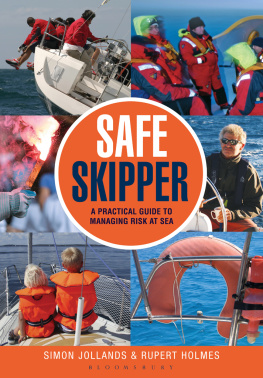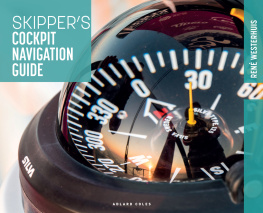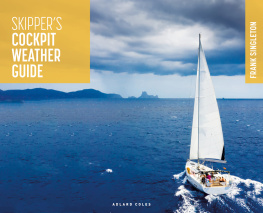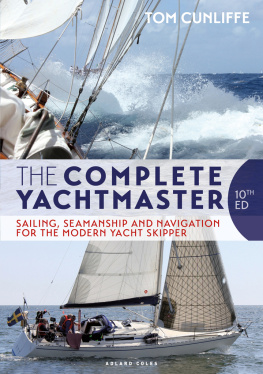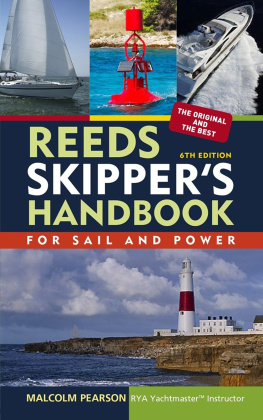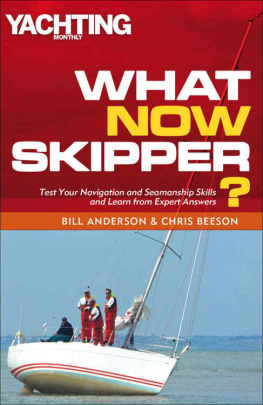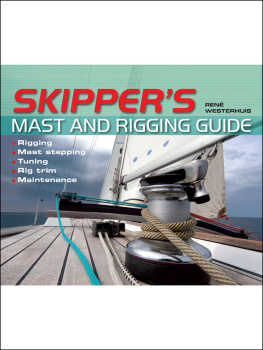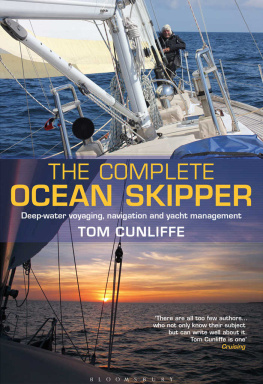
Adlard Coles Nautical
An imprint of Bloomsbury Publishing Plc
50 Bedford Square, London, WC1B 3DP,
UK 1385 Broadway, New York, NY 10018, USA
www.bloomsbury.com
Bloomsbury is a registered trade mark of Bloomsbury Publishing Plc
First published 2015
This electronic edition published in 2015 by Bloomsbury Publishing Plc
Simon Jollands and Rupert Holmes, 2015
Simon Jollands and Rupert Holmes have asserted their right under the Copyright, Designs and Patents Act, 1988, to be identified as Author of this work.
All rights reserved
You may not copy, distribute, transmit, reproduce or otherwise make available this publication (or any part of it) in any form, or by any means (including without limitation electronic, digital, optical, mechanical, photocopying, printing, recording or otherwise), without the prior written permission of the publisher. Any person who does any unauthorised act in relation to this publication may be liable to criminal prosecution and civil claims for damages.
No responsibility for loss caused to any individual or organization acting on or refraining from action as a result of the material in this publication can be accepted by Bloomsbury or the author.
British Library Cataloguing-in-Publication Data A catalogue record for this book is available from the British Library.
ISBN: | PB: | 978-1-4729-0914-5 |
ePDF: | 978-1-4729-1548-1 |
ePub: | 978-1-4729-1547-4 |
To find out more about our authors and books visit www.bloomsbury.com. Here you will find extracts, author interviews, details of forthcoming events and the option to sign up for our newsletters.
Cover photographs (clockwise from top left)
Shutterstock Rick Tomlinson Photography Kass Schmitt
Simon Jollands Shutterstock Patrick Roach Picture Agency
Acknowledgements
The authors would like to thank the following individuals and organisations for their help and contributions to this book:
Mark Bowden
Brendan Hall
Clipper Ventures
Paul Harrison at Seavoice Training
Paul Hopkins at Starboard First Aid
Vaclav Hornik at Windguru
Richard Hudson
KZ Marine Group
Lagoon Watersports
Liberty Yachts
The crew of Liver Bird: Kit Barton, Michael Bauch,
David Parrish, Tom Parrish
Ian Lockyer at Icom
Graham Nelson
The Royal National Lifeboat Institution
UK Met Office
Based on the Safe Skipper app available on the iTunes, Play and Amazon appstores see www.safe-skipper.com for more information.
Illustrations: Simon Jollands
Photo credits:
Stuart Batley .
CONTENTS
Introduction
We enjoy ourselves on the water knowing full well there are risks attached. The same applies to most sporting activities and many leisure pursuits, but this does not put us off indulging in such fulfilling pastimes. Whether we are going afloat for a few hours, a few days, a few weeks or longer, skippers of recreational vessels should always consider the margins of safety and ensure we are working within them. Good seamanship is an art that takes time to master. It calls for a combination of knowledge, experience, awareness, instinct and good working practices which are built up over a period of time, backed up with intensive training both ashore and afloat.
This book is not intended as a short cut that avoids the tried and tested processes that lead to good seamanship. Instead, we hope through identifying some of the key skills entailed, both novice and experienced skippers will find the content helpful and a useful reference for brushing up their knowledge, reducing risks when going afloat, ensuring the safety of crew and vessel comes first, being prepared for unexpected problems and for reminders of how to deal with them if they occur.
What is the secret of becoming a safe skipper? Partly this comes down to the mental attitude of the person responsible for their vessel and crew a calm, confident personality who does not shout at their crew, reassures the inexperienced, anticipates problems and avoids unnecessary risks. All are great attributes but count for little if the fundamental skills of seamanship are lacking. Perhaps above all a safe skipper is someone who never underestimates the sea.
PREPARATION
Principles of seaworthiness and seamanship
Safety at sea is not as simple as just spending money adding shiny new emergency equipment such as liferafts, dan buoys, distress flares, EPIRBs and so on.
While these items are of course important, its better to view them as an insurance that offers a potential lifeline when things have already gone badly wrong. They are, in effect, the nautical equivalent of the airbags in your car: very reassuring to have, but nevertheless items you will not need to activate.
More than anything else, what keeps us safe at sea is our attitude to risk. Given that its impossible to eliminate risk, we have to be continuously alive to the constantly changing situations that are an inevitable part of going to sea, analysing them for dangers so that any current or future risks can be identified. Its then possible to build into your plans ways to mitigate these risks, along with a margin of safety thats appropriate to the prevailing conditions.
So what are the biggest potential dangers youre likely to encounter? Fortunately, the list is surprisingly short. For individual crew members the key hazards are:
1. Fatigue, seasickness and hypothermia
2. Sunburn and sunstroke
3. Accidents involving dinghies and tenders
4. Head injuries from the boom or mainsheet
5. Falling overboard
6. Crushing fingers in a winch
The biggest dangers to the boat itself that may lead to serious incidents are as follows:
1. Bumping into solid objects such as land, rocks or other vessels
2. Failure of key equipment
3. Severe weather
4. Fire
5. Sinking
Given the potential dangers of the sea, both lists are surprisingly short. Of course, there are other things that may go wrong, but most other crisis situations you might encounter, while potentially frightening at the time, are less likely to be life-threatening or result in serious injury.
Cascade of events
When serious incidents at sea are analysed, one factor always stands out: very few have a single cause. Instead, most are the result of a chain of events with a catastrophic conclusion. In many cases, it would only require any one of the many links in the chain to be broken to stop the situation cascading into an ever more serious state.
The most important lesson to draw from this is that, when faced with a potential emergency situation, it must be tackled in a calm and logical fashion. That may sound obvious and straightforward, but when things start to go wrong the reality is that it will require a sustained and conscious effort to avoid running around in an adrenaline-fuelled panic that can easily make things worse.
Rather than attempting to make instant life or death decisions when the pressure is on, its easier to remember drills and routines thats why man overboard drill practice is so important. Equally, for an inexperienced crew, frequent practice at reefing is also beneficial, and the same holds true for anchoring. The more these and other activities are routine, the easier it is to carry them out under pressure, without creating new problems.

